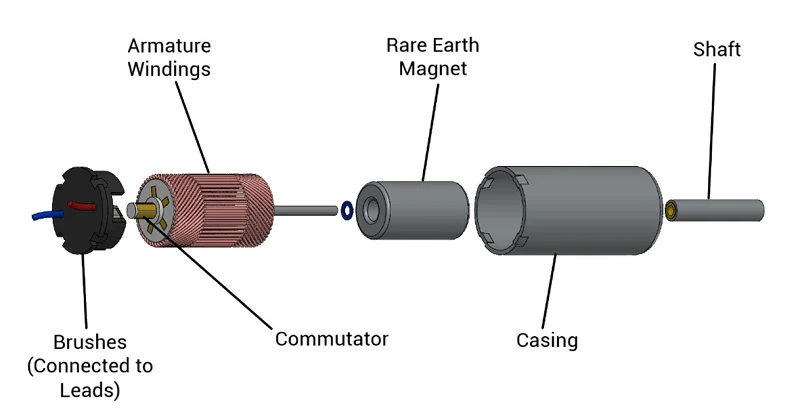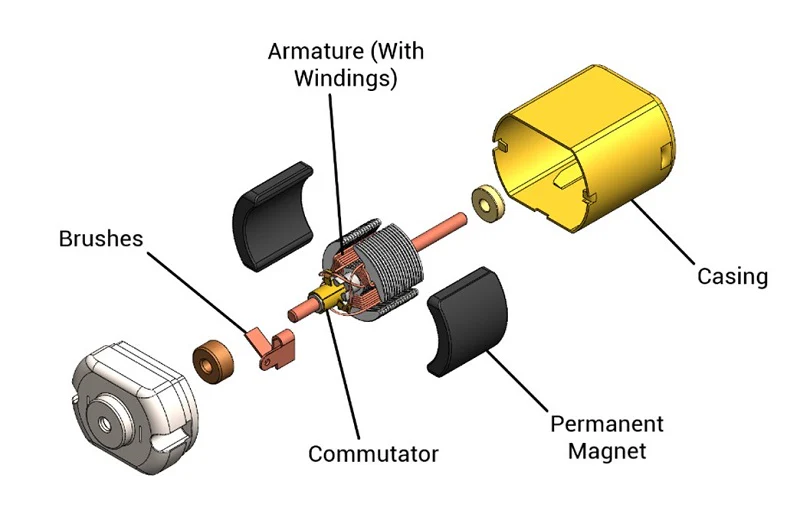There are two main types of brushless DC motors: coreless and cored. In this article, we’ll take a deep dive into the differences between coreless and cored brushless DC motors, comparing their construction, performance, and best use cases.
Basic Structure of Brushless DC Motors
Prior to dissecting the variations, it is crucial to comprehend the essential elements of brushless DC motors:
- Rotor: Spins inside the motor and is made up of permanent magnets.
- Stator: The fixed component that contains the coils or windings that produce the electromagnetic field.
- Electronic controller: Replaces the traditional commutator and brushes, controlling the current flow to the windings, and ensuring smooth operation.
The key difference between coreless and cored BLDC motors lies in the construction of the stator and rotor, which impacts motor performance in terms of speed, efficiency, and torque.
Structural Differences
Coreless BLDC Motor

CoredL BLDC Motor

| Feature | Cored BLDC Motor | Coreless BLDC Motor |
| Rotor Composition | Iron core with windings | Windings without iron core |
| Stator Composition | Stationary coils with magnets | Stationary coils with magnets |
| Inertia | Higher, due to iron core mass | Low, due to the absence of iron core |
| Winding Configuration | Fixed around an iron core | Air-cored or free-standing |
| Magnetic Field Strength | Stronger magnetic flux due to iron core | Weaker, but optimized for lightweight |
| Size and Weight | Larger and heavier | Compact and lightweight |
| Cost | Lower, simpler construction | Higher, more complex design |
The coreless BLDC motor’s unique rotor construction without an iron core leads to major performance differences, especially in applications requiring quick responsiveness, reduced vibration, and smooth operation.
Performance Characteristics
Inertia and Responsiveness
- Cored BLDC Motor: The presence of an iron core in the rotor increases the motor’s inertia, which can slow down its acceleration and deceleration. The added mass of the rotor reduces responsiveness, making the motor better suited for applications that do not require rapid speed changes.
- Coreless BLDC Motor: Without the iron core, the rotor is significantly lighter, leading to low inertia. This allows for rapid acceleration and deceleration, providing faster response times, which is critical in high-precision applications such as robotics and aerospace.
Torque Output
- Cored BLDC Motor: Due to the concentrated magnetic flux created by the iron core, cored BLDC motors generate higher torque at a given size. They are therefore perfect for uses needing a lot of torque, such as industrial machines or electric cars.
- Coreless BLDC Motor: The absence of an iron core results in reduced torque output. However, coreless motors are optimized for high-speed applications where lightweight design and efficiency are more important than sheer torque.
Efficiency
- Cored BLDC Motor: The iron core introduces eddy current losses and hysteresis, which reduce efficiency, especially at high speeds. While these motors are efficient in low to mid-speed operations, energy losses increase in demanding conditions.
- Coreless BLDC Motor: Without the iron core, coreless motors experience fewer losses related to eddy currents and hysteresis. This results in higher overall efficiency, particularly in high-speed applications, making them more energy-efficient in scenarios where prolonged operation is necessary.
Cogging Effect and Smoothness of Operation
- Cored BLDC Motor: One of the drawbacks of cored motors is the cogging effect, a jerky motion caused by the rotor’s magnets interacting with the stator’s teeth. This problem is most noticeable at low speeds, which may cause the device to operate less smoothly.
- Coreless BLDC Motor: The elimination of the iron core in the rotor also eliminates the cogging effect, providing a much smoother operation. This feature is highly desirable in precision applications where smooth motion is critical, such as medical devices or camera stabilization systems.
Thermal Management
- Cored BLDC Motor: The iron core in cored motors can trap heat, leading to potential thermal issues during continuous operation at high loads. While these motors are generally robust, they may require additional cooling systems for extended high-performance use.
- Coreless BLDC Motor: Coreless motors, with their open rotor design, naturally dissipate heat more efficiently. However, in some cases, their lower torque output may lead to overheating in high-load scenarios, though proper design can mitigate this risk.
Cost Considerations
- Cored BLDC Motor: The simpler construction of cored motors, which relies on widely available materials like iron, tends to make them more affordable. When budgetary restrictions are an issue or in large-scale industrial applications, this cost-effectiveness is advantageous.
- Coreless BLDC Motor: Because of their intricate design and unique material requirements, coreless motors are usually more costly. However, the performance benefits often justify the higher price, especially in applications where precision, efficiency, and compact size are essential.
Data Comparison
Below is a comparison of key performance metrics between coreless and cored BLDC motors.
| Feature | Cored BLDC Motor | Coreless BLDC Motor |
| Torque Density | Higher (5-10 Nm/kg) | Lower (2-5 Nm/kg) |
| Efficiency | 80-90% (moderate-speed operations) | 90-95% (high-speed operations) |
| Inertia | High (limits rapid acceleration) | Low (ideal for fast acceleration) |
| Cogging Effect | Noticeable at low speeds | Minimal or non-existent |
| Heat Dissipation | Requires external cooling at high loads | Naturally dissipates heat efficiently |
| Weight | Heavier (more robust for industrial use) | Lightweight (ideal for portable devices) |
| Cost | Lower | Higher |
Applications

Cored Brushless DC Motor Applications
- Industrial Equipment: The high torque output makes cored motors perfect for heavy-duty machinery such as conveyors, pumps, and CNC machines.
- Electric Vehicles (EVs): In EVs, torque is critical for propulsion, making cored motors a suitable choice for driving systems.
- Home Appliances: Applications like air conditioners, refrigerators, and washing machines benefit from the reliability and cost-effectiveness of cored motors.

Coreless Brushless DC Motor Applications
- Drones and UAVs: The lightweight design and high efficiency of coreless motors make them ideal for use in drones, where weight is a critical factor.
- Medical Devices: Coreless motors are used in medical pumps, prosthetics, and surgical tools due to their precise motion and compact size.
- Robotics: In applications where fast, precise movements are required, such as robotic arms or autonomous robots, coreless motors excel due to their low inertia and smooth operation.
Which Motor Should You Choose?
When selecting between a coreless and cored BLDC motor, the right choice depends on your specific application requirements:
Choose a Cored Brushless DC Motor if:
- High torque is required, especially in heavy-duty applications.
- Cost is a significant concern, and budget-friendly options are needed.
- The motor will be used in environments where size and weight are not critical, such as industrial machinery or automotive applications.
Choose a Coreless Brushless DC Motor if:
- Low inertia and high responsiveness are necessary, such as in precision robotics or aerospace applications.
- Energy efficiency is a priority, especially in high-speed, prolonged operations.
- Compact size and weight savings are critical, such as in drones, portable devices, or medical tools.
Conclusion
Brushless DC motors, whether iron-core or ironless, offer unique advantages and can be used in a variety of applications. Understanding these differences ensures the best choice for your specific needs, allowing coreless DC motor manufacturer to maximize the performance and efficiency of their products.
